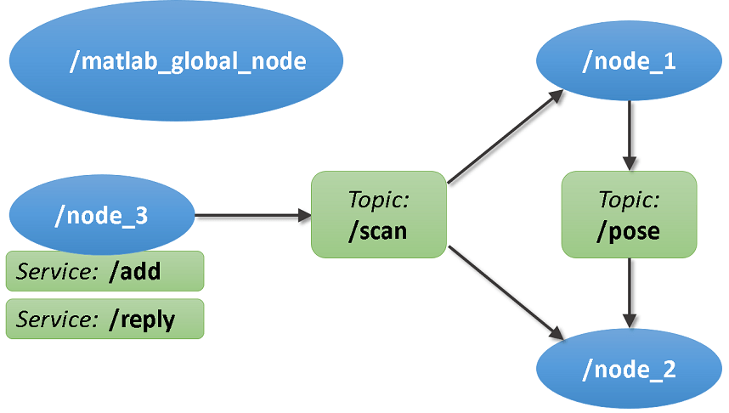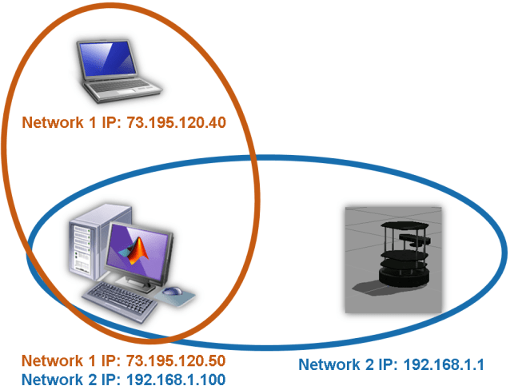Connect to ROS Network and Establish Communication
ROS Master and ROS Nodes
Nodes are the basic building blocks of ROS applications, which takes care of the computation. A ROS network consists of a single ROS master and multiple ROS nodes. The ROS master facilitates the communication in the ROS network by keeping track of all active ROS entities. Every node needs to register with the ROS master to be able to communicate with the rest of the network. MATLAB® can start the ROS master, or the master can be launched outside of MATLAB (for example, on a different computer).
Initialize ROS Network
To connect to a ROS network, you can create the ROS master in MATLAB or connect to an
existing ROS master. In both cases, MATLAB will also create and register its own ROS node (called the MATLAB
global node) with the master. To create the ROS master in
MATLAB, call rosinit function without any
arguments.
rosinit
Launching ROS Core... ..Done in 2.2595 seconds. Initializing ROS master on http://172.30.131.170:50105. Initializing global node /matlab_global_node_62502 with NodeURI http://bat6246win64:54321/ and MasterURI http://localhost:50105.
View ROS Network Information
Use rosnode
list to see all nodes in the ROS network. Note that the only
available node is the global node created by rosinit.
rosnode list/matlab_global_node_13423
Use exampleHelperROSCreateSampleNetwork to populate the ROS network
with three additional nodes and sample publishers and subscribers.
exampleHelperROSCreateSampleNetwork
Use rosnode
list again to see the three new nodes (node_1,
node_2, and node_3).
rosnode list/matlab_global_node_13423 /node_1 /node_2 /node_3
This figure shows the current state of the ROS network. The MATLAB global node is disconnected since it currently does not have any publishers, subscribers or services.

Shutdown ROS Network
Use rosshutdown to shut down the ROS master
and the global node
rosshutdown
Shutting down global node /matlab_global_node_62502 with NodeURI http://bat6246win64:54321/ and MasterURI http://localhost:50105. Shutting down ROS master on http://172.30.131.170:50105.
You can create multiple such nodes and establish communication between them by sending and receiving messages of different interface types.
Connect to External ROS Master
You can also use the rosinit command to connect to an external
ROS master (for example –– a ROS Master running on a robot or a virtual machine). You
can specify the address of the master in two ways:
Use an IP address.
Use hostname of the computer that runs the master.
After each call to rosinit, you have to call rosshutdown before calling rosinit with a different
syntax. For brevity, these calls to rosshutdown are omitted in these
examples.
'master_host' is an example host name and
'192.168.1.1' is an example IP address of the external ROS
master. Adjust these addresses depending on where the external master resides in your
network. These commands will fail if no master is found at the specified
addresses.
rosinit('192.168.1.1') rosinit('master_host')
Both calls to rosinit assume that the master accepts
network connections on port 11311, which is the standard ROS master port. If the master
is running on a different port, you can specify it as a second argument. To connect to a
ROS master running on host name master_host and port 12000, use the
following command:
rosinit('master_host',12000)
If you know the entire Uniform Resource Identifier (URI) of the master, you can create the global node and connect to this master using this syntax:
rosinit('http://192.168.1.1:12000')
Communication in ROS Network
Node Host Specification
In some cases, your computer may be connected to multiple networks and have multiple IP addresses, of which, this figure is an example:

The computer on the bottom left runs MATLAB and is connected to two different
networks. In one subnet, its IP address is 73.195.120.50, and in
the other, its IP is 192.168.1.100. This computer wants to
connect to the ROS master on the TurtleBot® computer at IP address
192.168.1.1. As part of the registration with the master, the
MATLAB global node has to specify the IP address or host name where other ROS nodes
can reach it. All the nodes on the TurtleBot will use this address to send data to
the global node in MATLAB.
When rosinit is invoked with the master's IP address, it tries
to detect the network interface used to contact the master and use that as the IP
address for the global node. If this automatic detection fails, you can explicitly
specify the IP address or host name by using the NodeHost
name-value pair in the rosinit call. The
NodeHost name-value pair can be used with any of the other
syntaxes already shown.
These commands advertise your computer's IP address to the ROS network as
192.168.1.100.
rosinit('192.168.1.1','NodeHost','192.168.1.100') rosinit('http://192.168.1.1:11311','NodeHost','192.168.1.100') rosinit('master_host','NodeHost','192.168.1.100')
Once a node is registered in the ROS network, you can see the address that it
advertises by using the command rosnode info
<nodename>. You can
see the names of all registered nodes by calling rosnode
list.
ROS Environment Variables
In advanced use cases, you might want to specify the address of a ROS master and your advertised node address through standard ROS environment variables. The syntaxes that were explained in the previous sections should be sufficient for the majority of your use cases.
If no arguments are provided to rosinit, the function will also
check the values of standard ROS environment variables. These variables are
ROS_MASTER_URI, ROS_HOSTNAME, and
ROS_IP. You can see their current values using the getenv command:
getenv('ROS_MASTER_URI') getenv('ROS_HOSTNAME') getenv('ROS_IP')
You can set these variables using the setenv command. After setting the
environment variables, call rosinit with no arguments. The
address of the ROS master is specified by ROS_MASTER_URI and the
global node's advertised address is given by ROS_IP or
ROS_HOSTNAME. If you specify additional arguments to
rosinit, they override the values in the environment
variables.
setenv('ROS_MASTER_URI','http://192.168.1.1:11311') setenv('ROS_IP','192.168.1.100') rosinit
You do not have to set both ROS_HOSTNAME and
ROS_IP. If both are set, ROS_HOSTNAME
takes precedence.
For your ROS connection to work correctly, you must ensure that all nodes can communicate with the master and with each other. The individual nodes must communicate with the master to register subscribers, publishers, and services. They must also be able to communicate with one another to send and receive data. If your ROS network is not set up correctly, it is possible to be able to send data and be unable to receive data (or vice versa).
ROS Communication Interfaces
You can communicate between ROS nodes using different interface types: